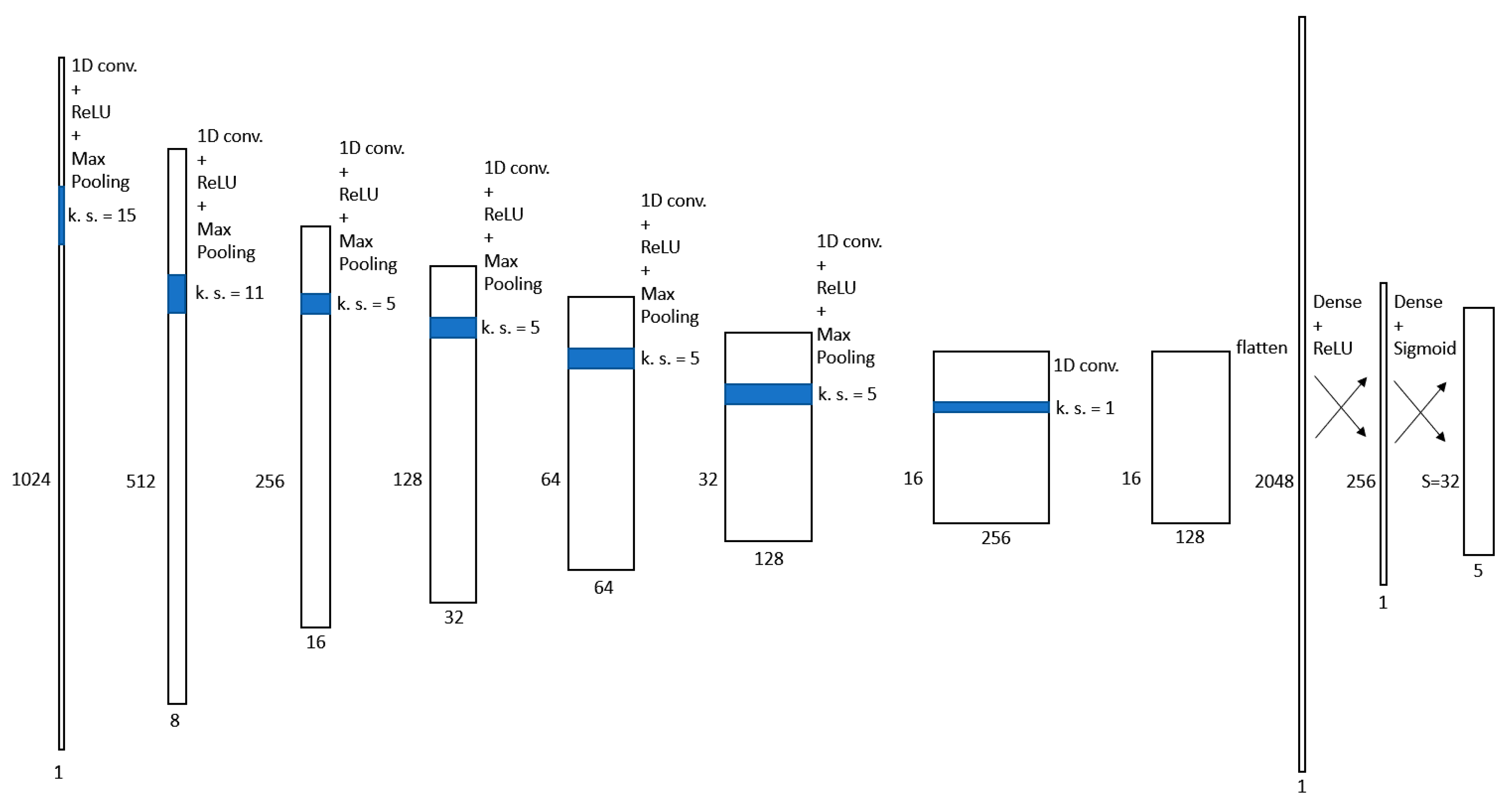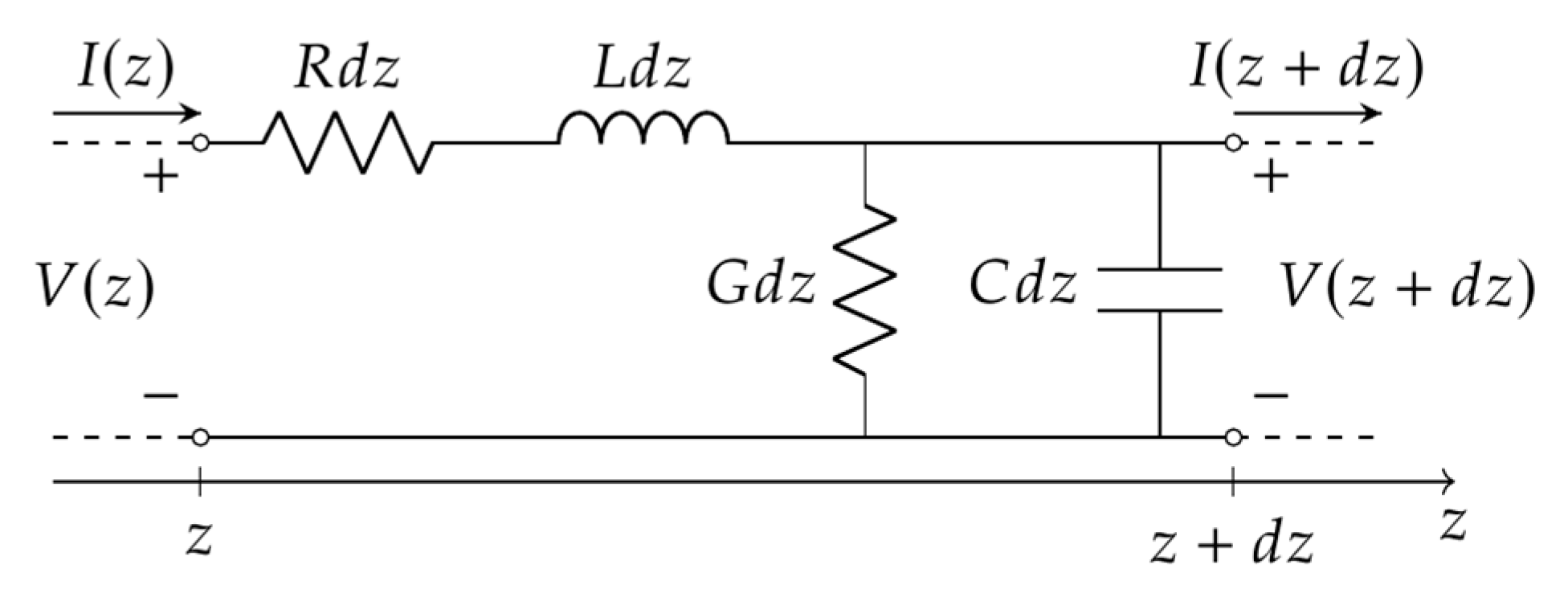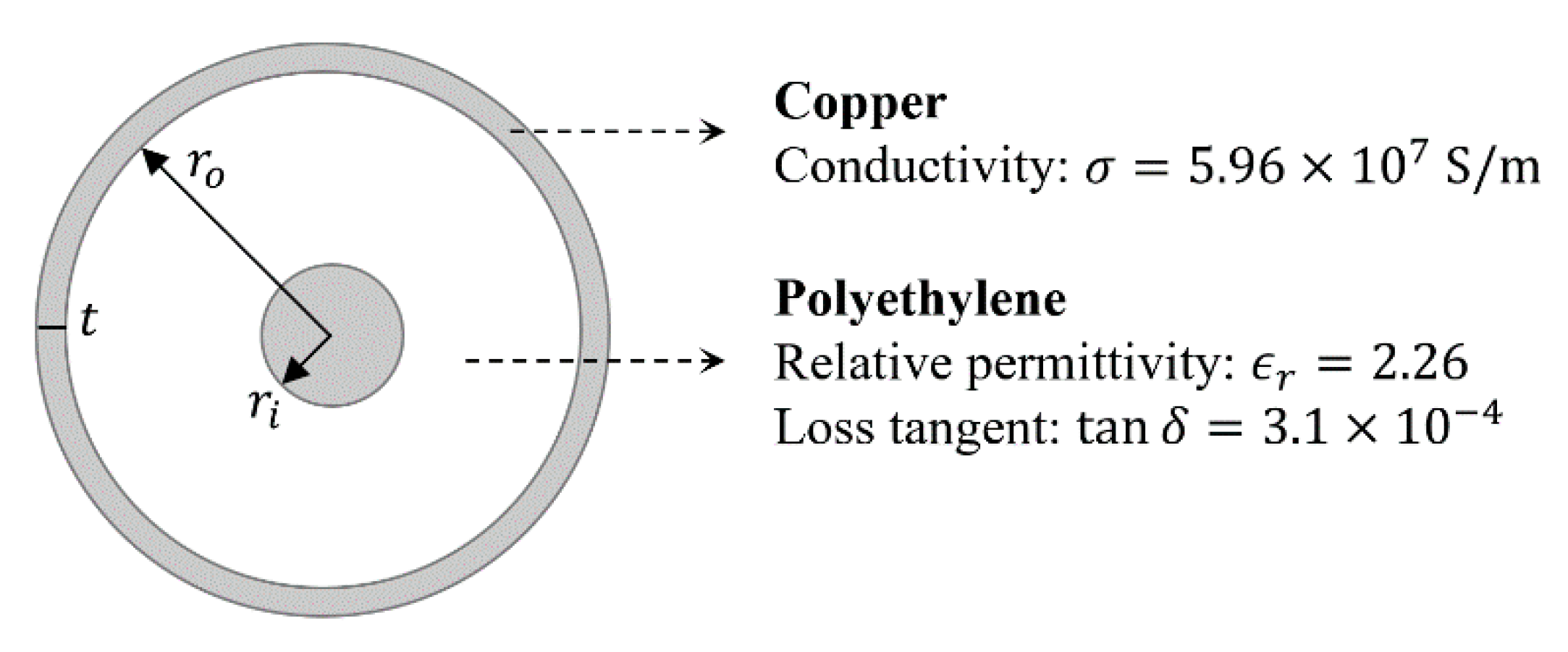Detection and Characterization of Multiple Discontinuities in Cables with Time-Domain Reflectometry and Convolutional Neural Networks
Abstract
:1. Introduction
- No pre-processing and extraction of features from the measured signals is required. This implies less computational burden and better exploitation of the deep learning paradigm. When working directly with raw data, deep neural networks can indeed select the optimal features to extract for the given task. Additionally, a more simple and general estimation procedure is obtained;
- Accurate localization and characterization of multiple discontinuity points in the cable;
- The neural network is trained using TDR signals generated with a transmission line simulator. Even though an accurate model of the cable is required to obtain good results, once it has been created, it can be used to generate training datasets to make the neural network work in different conditions;
- The neural network can work with any cable of the same type as those used in the training set, with a variable length.
2. Materials and Methods
2.1. Measurement Setup
2.2. Neural Network
- A total of 16 kernels of size ;
- A total of 32 kernels of size ;
- A total of 64 kernels of size ;
- A total of 128 kernels of size ;
- A total of 256 kernels of size .
- The first element indicated the normalized position of the discontinuity points relative to the range of lengths in the cell;
- The second and third elements indicated the class of the predicted discontinuity point. If the first of these two elements was greater than the second, a capacitive fault was predicted; an open termination of the line was predicted otherwise;
- The fourth element quantified the capacity value. This was also a normalized value relative to the range of possible capacity values. If a line termination was predicted, this value was neglected;
- The last element indicated the probability score of the prediction.
2.3. Dataset Generation and Training Procedure
2.3.1. Simulation Procedure
- —Inner conductor ray;
- —Outer conductor ray;
- —Outer conductor thickness;
- —Copper conductivity;
- —Insulator relative permittivity;
- —Insulator loss tangent.
2.3.2. Calibration of the RG58-CU Cable Parameters
2.3.3. Dataset Generation
2.3.4. Training of the Neural Network
3. Results and Discussion
3.1. Performance Assessment on the Validation Dataset
3.2. Performance Assessment on the Test Dataset (Experimental Data)
4. Conclusions
Author Contributions
Funding
Data Availability Statement
Conflicts of Interest
References
- Stevens, R.F.; Stringfield, T.W. A Transmission Line Fault Locator Using Fault-Generated Surges. Trans. Am. Inst. Electr. Eng. 1948, 67, 1168–1179. [Google Scholar] [CrossRef]
- Cataldo, A.; Tarricone, L.; Attivissimo, F.; Trotta, A. Simultaneous Measurement of Dielectric Properties and Levels of Liquids Using a TDR Method. Measurement 2008, 41, 307–319. [Google Scholar] [CrossRef]
- Cataldo, A.; De Benedetto, E.; Cannazza, G.; Piuzzi, E.; Pittella, E. TDR-Based Measurements of Water Content in Construction Materials for In-the-Field Use and Calibration. IEEE Trans. Instrum. Meas. 2018, 67, 1230–1237. [Google Scholar] [CrossRef]
- Wilczek, A.; Szypłowska, A.; Skierucha, W.; Cieśla, J.; Pichler, V.; Janik, G. Determination of Soil Pore Water Salinity Using an FDR Sensor Working at Various Frequencies up to 500 MHz. Sensors 2012, 12, 10890–10905. [Google Scholar] [CrossRef] [PubMed]
- Skierucha, W.; Wilczek, A. A FDR Sensor for Measuring Complex Soil Dielectric Permittivity in the 10–500 MHz Frequency Range. Sensors 2010, 10, 3314–3329. [Google Scholar] [CrossRef] [PubMed] [Green Version]
- Schiavoni, R.; Monti, G.; Piuzzi, E.; Tarricone, L.; Tedesco, A.; De Benedetto, E.; Cataldo, A. Feasibility of a Wearable Reflectometric System for Sensing Skin Hydration. Sensors 2020, 20, 2833. [Google Scholar] [CrossRef] [PubMed]
- Wang, K.; Lin, C.-P.; Jheng, W.-H. A New TDR-Based Sensing Cable for Improving Performance of Bridge Scour Monitoring. Sensors 2020, 20, 6665. [Google Scholar] [CrossRef] [PubMed]
- Cataldo, A.; Schiavoni, R.; Masciullo, A.; Cannazza, G.; Micelli, F.; De Benedetto, E. Combined Punctual and Diffused Monitoring of Concrete Structures Based on Dielectric Measurements. Sensors 2021, 21, 4872. [Google Scholar] [CrossRef] [PubMed]
- Zhou, Z.; Jiao, T.; Zhao, P.; Liu, J.; Xiao, H. Development of a Distributed Crack Sensor Using Coaxial Cable. Sensors 2016, 16, 1198. [Google Scholar] [CrossRef] [PubMed] [Green Version]
- Yu, J.-D.; Kim, S.Y.; Lee, J.-S. Variations in Velocity and Sensitivity of Electromagnetic Waves in Transmission Lines Configured in Model Piles with Necking Defects Containing Soils. Sensors 2020, 20, 6541. [Google Scholar] [CrossRef] [PubMed]
- Lee, C.-K.; Shin, Y.-J. Detection and Assessment of I&C Cable Faults Using Time–Frequency R-CNN-Based Reflectometry. IEEE Trans. Ind. Electron. 2021, 68, 1581–1590. [Google Scholar] [CrossRef]
- Lim, H.; Kwon, G.-Y.; Shin, Y.-J. Fault Detection and Localization of Shielded Cable via Optimal Detection of Time–Frequency Domain Reflectometry. IEEE Trans. Instrum. Meas. 2021, 70, 1–10. [Google Scholar] [CrossRef]
- Osman, O.; Sallem, S.; Sommervogel, L.; Carrion, M.O.; Bonnet, P.; Paladian, F. Distributed Reflectometry for Soft Fault Identification in Wired Networks Using Neural Network and Genetic Algorithm. IEEE Sens. J. 2020, 20, 4850–4858. [Google Scholar] [CrossRef]
- Lee, C.-K.; Chang, S.J. Fault Detection in Multi-Core C&I Cable via Machine Learning Based Time-Frequency Domain Reflectometry. Appl. Sci. 2020, 10, 158. [Google Scholar] [CrossRef] [Green Version]
- Alvarenga, T.A.; Cerqueira, A.S.; Filho, L.M.A.; Nobrega, R.A.; Honorio, L.M.; Veloso, H. Identification and Localization of Track Circuit False Occupancy Failures Based on Frequency Domain Reflectometry. Sensors 2020, 20, 7259. [Google Scholar] [CrossRef] [PubMed]
- Kwon, G.-Y.; Lee, C.-K.; Shin, Y.-J. Diagnosis of Shielded Cable Faults via Regression-Based Reflectometry. IEEE Trans. Ind. Electron. 2019, 66, 2122–2131. [Google Scholar] [CrossRef]
- Scarpetta, M.; Spadavecchia, M.; Andria, G.; Ragolia, M.A.; Giaquinto, N. Analysis of TDR Signals with Convolutional Neural Networks. In Proceedings of the 2021 IEEE International Instrumentation and Measurement Technology Conference (I2MTC), Glasgow, UK, 17–20 May 2021; pp. 1–6. [Google Scholar]
- Liu, W.; Anguelov, D.; Erhan, D.; Szegedy, C.; Reed, S.; Fu, C.-Y.; Berg, A.C. SSD: Single Shot MultiBox Detector. In Computer Vision—ECCV 2016, Proceedings of the Computer Vision—ECCV 2016, Amsterdam, The Netherlands, 11–14 October 2016; Leibe, B., Matas, J., Sebe, N., Welling, M., Eds.; Springer International Publishing: Cham, Switzerland, 2016; pp. 21–37. [Google Scholar]
- Redmon, J.; Divvala, S.; Girshick, R.; Farhadi, A. You Only Look Once: Unified, Real-Time Object Detection. In Proceedings of the 2016 IEEE Conference on Computer Vision and Pattern Recognition (CVPR), Las Vegas, NV, USA, 27–30 June 2016; pp. 779–788. [Google Scholar]
- D’Aucelli, G.M.; Giaquinto, N.; Andria, G. LineLab-A Transmission Line Simulator for Distributed Sensing Systems: Open-Source MATLAB Code for Simulating Real-World Transmission Lines. IEEE Antennas Propag. Mag. 2018, 60, 22–30. [Google Scholar] [CrossRef]
- Giaquinto, N.; Scarpetta, M.; Spadavecchia, M. Algorithms for Locating and Characterizing Cable Faults via Stepped-Frequency Waveform Reflectometry. IEEE Trans. Instrum. Meas. 2020, 69, 7271–7280. [Google Scholar] [CrossRef] [Green Version]
- Kingma, D.P.; Ba, J. Adam: A Method for Stochastic Optimization. arXiv 2014, arXiv:1412.6980. [Google Scholar]
- Scarpetta, M.; Spadavecchia, M.; Adamo, F.; Ragolia, M.A.; Giaquinto, N. Supplementary Material for the Paper “Detection and Characterization of Multiple Discontinuities in Cables with Time Domain Reflectometry and Convolutional Neural Networks”. 2021. Available online: https://zenodo.org/record/5720438 (accessed on 28 November 2021). [CrossRef]







| Number of Faults | Distance between Discontinuity Points (m) | Total Length of the Cable (m) | Capacity of the Faults (pF) | |
|---|---|---|---|---|
| Min | 0 | 10 | 10 | 50 |
| Max | 4 | - | 200 | 500 |
| Cable Length Error | Fault Position Error | Fault Capacity Error | |||
|---|---|---|---|---|---|
| RMSE (m) | MAPE | RMSE (m) | MAPE | RMSE (pF) | MAPE |
| 0.070 | 0.059% | 0.066 | 0.091% | 11 | 1.2% |
| Position of the Fault (m) | Capacity of the Fault (pF) | Length of the Cable (m) | |||
|---|---|---|---|---|---|
| Nominal | Estimated | Nominal | Estimated | Nominal | Estimated |
| 50 | 49.94 | 107 | 112 | 65 | 65.00 |
| 50 | 49.92 | 152 | 158 | 65 | 65.01 |
| 50 | 49.97 | 217 | 205 | 65 | 64.92 |
| 50 | 49.92 | 309 | 310 | 65 | 64.95 |
| 50 | 49.96 | 404 | 434 | 65 | 65.01 |
| 50 | 49.99 | 450 | 450 | 65 | 64.96 |
| Position of Fault 1 (m) | Capacity of Fault 1 (pF) | Position of Fault 2 (m) | Capacity of Fault 2 (pF) | Length of the Cable (m) | |||||
|---|---|---|---|---|---|---|---|---|---|
| Nominal | Estimated | Nominal | Estimated | Nominal | Estimated | Nominal | Estimated | Nominal | Estimated |
| 15 | 15.04 | 107 | 112 | 65 | 65.10 | 152 | 156 | 81 | 81.05 |
| 15 | 15.04 | 107 | 113 | 65 | 65.21 | 217 | 206 | 81 | 80.97 |
| 15 | 15.05 | 107 | 112 | 65 | 65.18 | 450 | 451 | 81 | 80.80 |
| 15 | 15.13 | 217 | 206 | 65 | 65.03 | 309 | 309 | 81 | 80.83 |
| 15 | 15.12 | 217 | 206 | 65 | 65.02 | 404 | 433 | 81 | 80.84 |
| 15 | 15.14 | 450 | 459 | 65 | 65.14 | 404 | 430 | 81 | 80.69 |
| Experiment 1 | Experiment 2 | |||
| Nominal | Estimated | Nominal | Estimated | |
| Length of the Cable (m) | 131 | 130.99 | 131 | 130.93 |
| Position of Fault 1 (m) | 50 | 49.90 | 50 | 49.93 |
| Position of Fault 2 (m) | 65 | 65.06 | 65 | 64.99 |
| Position of Fault 3 (m) | 115 | 115.09 | 115 | 114.92 |
| Capacity of Fault 1 (pF) | 107 | 115 | 217 | 214 |
| Capacity of Fault 2 (pF) | 217 | 210 | 450 | 454 |
| Capacity of Fault 3 (pF) | 404 | 431 | 404 | 418 |
| Experiment 1 | Experiment 2 | |||
|---|---|---|---|---|
| Nominal | Estimated | Nominal | Estimated | |
| Length of the Cable (m) | 143 | 142.96 | 143 | 142.96 |
| Position of Fault 1 (m) | 50 | 49.87 | 50 | 49.88 |
| Position of Fault 2 (m) | 65 | 65.12 | 65 | 65.03 |
| Position of Fault 3 (m) | 115 | 114.93 | 115 | 114.95 |
| Position of Fault 4 (m) | 131 | 131.40 | 131 | 131.32 |
| Capacity of Fault 1 (pF) | 107 | 117 | 107 | 115 |
| Capacity of Fault 2 (pF) | 217 | 214 | 152 | 165 |
| Capacity of Fault 3 (pF) | 404 | 436 | 309 | 323 |
| Capacity of Fault 4 (pF) | 450 | 441 | 450 | 439 |
| Cable Length Error | Fault Position Error | Fault Capacity Error | |||
|---|---|---|---|---|---|
| RMSE (m) | MAPE | RMSE (m) | MAPE | RMSE (pF) | MAPE |
| 0.12 | 0.10% | 0.13 | 0.22% | 14 | 4.3% |
Publisher’s Note: MDPI stays neutral with regard to jurisdictional claims in published maps and institutional affiliations. |
© 2021 by the authors. Licensee MDPI, Basel, Switzerland. This article is an open access article distributed under the terms and conditions of the Creative Commons Attribution (CC BY) license (https://creativecommons.org/licenses/by/4.0/).
Share and Cite
Scarpetta, M.; Spadavecchia, M.; Adamo, F.; Ragolia, M.A.; Giaquinto, N. Detection and Characterization of Multiple Discontinuities in Cables with Time-Domain Reflectometry and Convolutional Neural Networks. Sensors 2021, 21, 8032. https://doi.org/10.3390/s21238032
Scarpetta M, Spadavecchia M, Adamo F, Ragolia MA, Giaquinto N. Detection and Characterization of Multiple Discontinuities in Cables with Time-Domain Reflectometry and Convolutional Neural Networks. Sensors. 2021; 21(23):8032. https://doi.org/10.3390/s21238032
Chicago/Turabian StyleScarpetta, Marco, Maurizio Spadavecchia, Francesco Adamo, Mattia Alessandro Ragolia, and Nicola Giaquinto. 2021. "Detection and Characterization of Multiple Discontinuities in Cables with Time-Domain Reflectometry and Convolutional Neural Networks" Sensors 21, no. 23: 8032. https://doi.org/10.3390/s21238032
APA StyleScarpetta, M., Spadavecchia, M., Adamo, F., Ragolia, M. A., & Giaquinto, N. (2021). Detection and Characterization of Multiple Discontinuities in Cables with Time-Domain Reflectometry and Convolutional Neural Networks. Sensors, 21(23), 8032. https://doi.org/10.3390/s21238032







